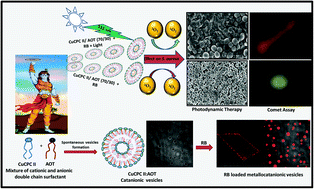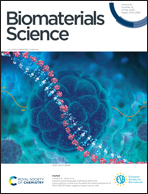High antimicrobial photodynamic activity of photosensitizer encapsulated dual-functional metallocatanionic vesicles against drug-resistant bacteria S. aureus†
Abstract
Developments in the field of photodynamic therapy (PDT) are being made by investigating appropriate photosensitizers (PSs) and enhancing the penetration effect of light by developing new nano-carriers. So, to boost the PDT effect, in the present work, new metallocatanionic vesicles were fabricated by a convenient, efficient, green and inexpensive method to encapsulate PSs and evaluate their antimicrobial PDT against the drug-resistant bacterium Staphylococcus aureus. They were prepared from a combination of a double-chained copper-based cationic metallosurfactant (CuCPCII) and an anionic surfactant sodium bis(2-ethylhexyl)sulfosuccinate (Aerosol OT or AOT). The surface charge, structure and ability to encapsulate oppositely charged photosensitizers are some crucial factors that need to be controlled for their effective utilization in PDT. In this approach, two of the fractions, one each from a cationic rich and anionic rich side, were selected to encapsulate cationic (methylene blue; MB) and anionic (rose bengal (RB)) PSs after characterization by SAXS, AFM, FESEM, DLS, and zeta-potential, and conductivity measurements. Afterwards, PDT was performed on S. aureus (a multidrug-resistant bacterium) by the colony forming unit (CFU) method using PS encapsulated metallocatanionic vesicles that demonstrated high bactericidal activity by using visible light (532 nm) and facilitated the generation of singlet oxygen. The singlet oxygen generation capability of both the PSs was enhanced under irradiation when encapsulated in metallocatanionic vesicles because the presence of metal accelerated the intersystem crossing of triplet oxygen to singlet oxygen. Furthermore, these studies reveal that the metallocatanionic vesicles have dual functionality i.e. encapsulate PSs and even show dark toxicity against S. aureus. To study the killing of S. aureus, bacterial DNA was extracted and its interactions and conformational changes in the presence of metallocatanionic vesicles were analyzed via., UV-Visible, and circular dichroism (CD) spectroscopy. Comet assay (single-cell gel-electrophoresis) demonstrated the DNA damage after PDT treatment in an individual cell. The bacterial DNA damage was more with the metallosurfactant rich 70 : 30 fraction than with the 30 : 70 fraction, in combination with RB under irradiation. This work provides a new metal hybrid smart material that possesses dual functionality and is prepared by an easy, economical and feasible procedure which resulted in enhanced PDT against a drug-resistant bacterium, thus, providing an alternative for antibacterial therapy.



 Please wait while we load your content...
Please wait while we load your content...